Tech Review: 10000 mAh TP-LINK TL-PB50 Power Bank
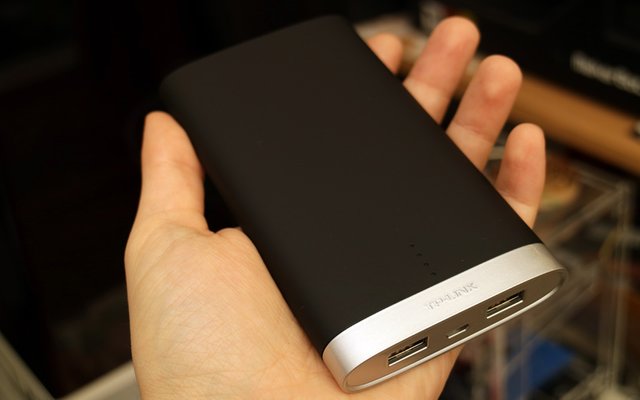
What Are Power Banks and Why Do You Need One
Power Banks are small battery packs that you can carry around with you and use to charge any other USB gadget that may run out of juice, such as your smartphone for example, though anything else with USB charging should work. These "mobile batteries" come in various sizes, capacities and with different capabilities, but one thing is certain - you definitely need one for emergency situations, and not only then actually.
Is Pokemon Go one of these emergencies, it actually is for many people out there. The release of the popular mobile game has essentially led to a skyrocketing of the sales of all kinds of different power banks. Not all of these mobile batteries are good and safe, especially now that the market is also full of all kinds of cheap Chinese brands where the price matters more than the quality and the safety. That may not be a good thing when you are carrying a Lithium battery in your pocket or in your bagpack and it suddenly catches fire for example. So do have that in mind the next time you are shopping for a power bank and the cheapest model catches your attention first.
Why do you need one, besides for playing Pokemon Go, what about if you don't play it? We are already used to having to charge most of our battery-powered gadgets every day, just to be sure that they will have enough charge when we need them. The smartphones did that to us as most of these do not last more than a day of normal use with a single charge, but there are now a ton of other gadgets that also recharge via USB and you want to have these charged when you need them. It is not like you can charge your smartphone anywhere you go, so having a power bank in your pocket or bad can actually allow you to do so and not have your phone die on you when you need it most.
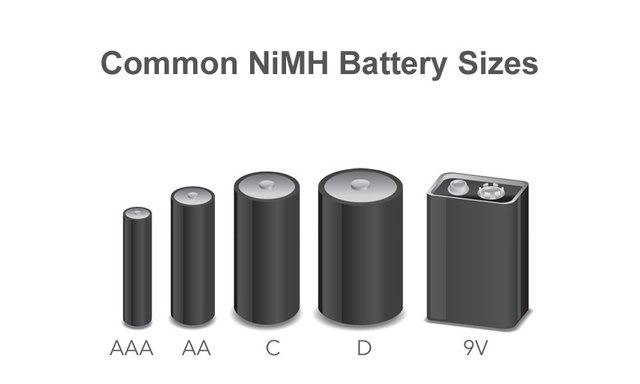
Some Myths About Batteries
A lot of people seem to still believe that it is best to have their battery-powered devices discharge almost completely and then and just then to start charging them. They believe this to be true for smartphones as well as other devices using Lithium-based rechargeable batteries. While this can be true for some devices that use NiMH-based rechargeable batteries or a different older battery technology, it is not something you need to do for Lithium-based rechargeable batteries at all.
In fact waiting for your smartphone's battery to get in the red zone and just then thinking about plugging it to charge is actually bad for the battery of the device on the long term. It is bad, because it reduced the number of charge cycles that are left for the battery and if you do charge the battery of the smartphone every day then it will take less time for the battery to start holding less charge and to start to perform worse. If you charge your phone using regular charge when you have the opportunity, then you can pretty much extend the life of the battery inside the device. This is especially useful for smartphones where the user cannot easily replace the battery of the device, because for that the device needs to be disassembled.
The same myth about having to leave your smartphone, or other mobile device, with a Lithium battery for hours connected to the charger on its first charge is also just a myth. A myth that found its roots in some older technologies for rechargeable batteries years ago, where it was actually useful. So just forget about that one as well. Devices such as smartphones use smart battery charging technology, so when the battery is fully charged there is no more power sent to the battery, so nothing will change if you leave your device fully charged for hours connected to a charger. Nothing more than the fact that when you disconnect it from the charger the battery will be at 100%.
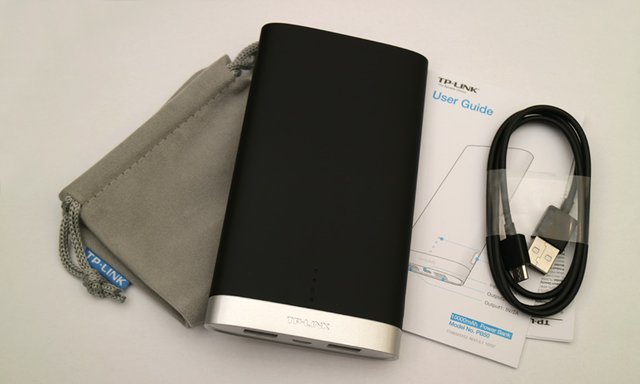
The TP-LINK TL-PB50 10 Ah Power Bank
So how about taking a look at what a good power bank should be able to provide the user with, apart from large capacity and thus the ability to recharge the battery of his/hers smartphone a couple to times. TP-LINK TL-PB50 Power Bank is one such battery that I have been using for quite a while and that I'm really happy with, though definitely one of the cheapest out there, it is really worth the extra money. TP-LINK is a company that is popular mostly with their WiFi routers and other network products, though they are making some other things like power banks as well as they apparently make good ones as you will soon find out.
Specifications of the TP-LINK TL-PB50:
Battery Capacity: 10000 mAh
Battery Type: Lithium Polymer
USB input: 5V/2A
USB output: 5V/1A, 5V/2A
Indicators: 4 LEDs for the charge level
Dimensions: 139.7x78.9x19.3 mm
Weight: 281.3 grams
Compatibility: iPhone, iPad, iPod, Android smartphones and others
Time to charge internal battery: 1A input - 9 hours and 32 minutes, 2A input - 6 hours and 8 minutes (according to the manufacturer)
Package contents: Power Bank PB50, USB-Micro USB cable, User Guide, Carrying Pouch
This power bank can charge one or two devices at the same time as it has two charging ports, though one is for devices that can take a higher input charge of 2A and the other is up to 1A. If you connect a device with lower input power to the 2A port the power bank will automatically supply less power to that device, so that it will not burn of course.
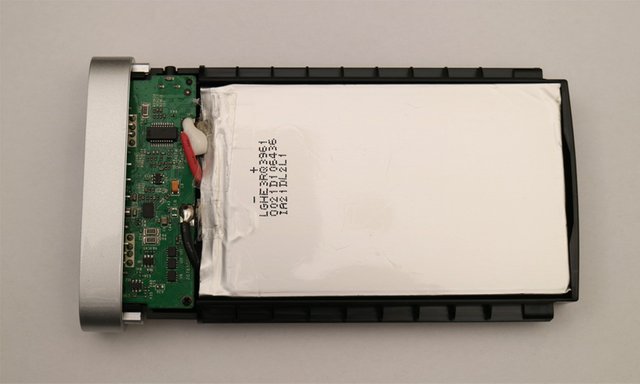
The internal Lithium-polymer battery cell in the power bank is rated at 500 recharge cycles, so that means you will get much more recharges of your smartphone’s battery thanks to the large 10000 mAh capacity that it offers. The battery cell inside the TP-LNK power bank is a high-quality single cell LiPo battery apparently made by LG, so it is not some cheap Chinese cell with a capacity rating that has nothing to do with the reality.
Lithium polymer battery cells from LG offers superior safety through the improvement of the durability and heat resistance of batteries by applying nano ceramic coating and through reducing of short circuits inside the battery by using porous PO material with high ventilation.
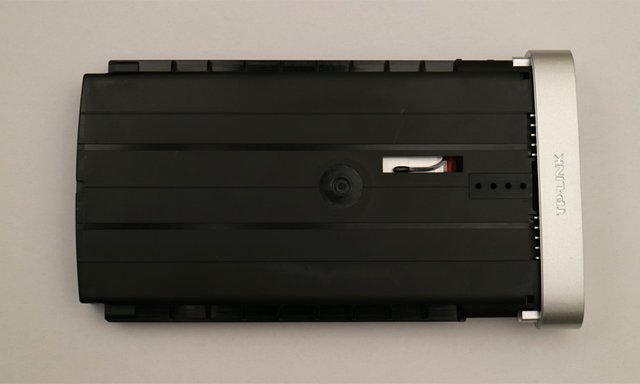
TP-LINK did design this power bank quite well so that it retained relatively compact size, even though it houses a high capacity Lithium battery inside. Their design however also incorporates other useful things regarding the protection from possible issues, one of the important, yet often overlooked things about devices using Lithium-based rechargeable batteries.
There is an external thermal sensor that monitors and reports the external temperature of the battery cell in order to prevent it from overheating. The electronics of the power bank also monitors and prevents over-charging and over-discharging of the battery cell thus supposedly eliminating the chances of the battery cell causing you trouble or dying from over discharge. There is also a short circuit and over-current protection if there is a problem with the cable to the device that you might plug to be charged by the power bank. So the safety level of the power bank is at a pretty good level, especially when compared to the lack of any or just a few of these protection mechanisms in most cheap power banks out there.
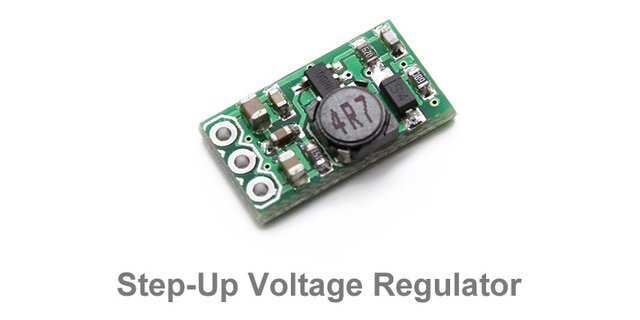
When and Why 10 Ah are not exactly 10 Ah
There is a bit of a misunderstanding how a power bank works and some people believe that if they get a mobile battery with a capacity of 10000 mAh they should be able to charge a smartphone with a 2000 mAh battery at least 5 times. This however is not going to happen and there is a very simple reason for that - the way that charging and batteries work. The harsh reality is that you get less out of the power bank and you need to put more to charge it.
Let me try to explain how things work when charging the battery inside the power bank and when you are using that battery to charge other devices such as your smartphone. USB power uses 5 V, however Lithium-based rechargeable batteries like the ones used in smartphones and power banks operate at a lower voltage. Usually a single cell Lithium battery is rated at 3.7V, however the actual voltage of the battery varies, depending on its charge level. So for example a fully charged Lithium-Polymer battery should be at about 4.2V and when it is fully discharged it usually gets down to about 3V-3.2V (depending on the battery protection circuit).
If you have a lower voltage input source like a battery at 4.2V that needs to output 5V you need to have some electronics that will increase the voltage or a Step-Up Voltage Regulator. Since the charger for your smartphone is a USB-based one it accepts 5V input, but also needs to bring it down to 4.2V for example as the battery inside the device is the same as the one found in the power bank, so here we need a Step-Down Voltage Regulator. When these voltage regulators do their "magic" to convert the voltage there is some loss as they are not 100% efficient and the loss is in the form of heat. If you are wondering why power banks get hot when they are being charged and may also get hot when they are used for charging other devices as well why you smartphone also gets hotter when being charged - this is the reason, the loss of some energy as heat during the conversion process to bring down or up the voltage.
As I said the efficiency is never 100%, it is usually in the range of about 70% and 90%, though there could be cheaper and less efficient as well as more expensive and more efficient regulators used that can get lower or higher than these typical numbers. Power bank manufacturers usually cite the efficiency of the energy conversion of their products only if it is a high one that works to attract potential buyers, otherwise they keep it a secret and focus on other marketing aspects of their products like a lower price for example.
Furthermore the efficiency between a step-up and step-down conversion of voltage varies. For example when you have a lower voltage that you need to make higher the conversion is less efficient than when you need to lower a higher voltage. In the case of a power bank we have a battery starting at 4.2V that needs to output 5V, however as it gets discharged its voltage drops down to lets us say 3.2V and it still needs to output 5V. This means that the more you discharge the power bank, the less efficient the power conversion will be because of the increasing difference between the input and output voltages.
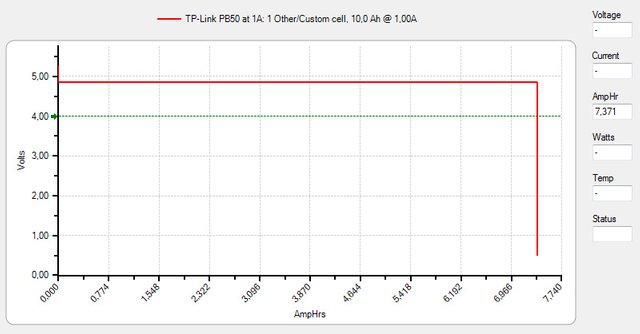
Test Results with the TP-LINK TL-PB50 Power Bank
Ok, so how well does the 10 Ah Power Bank from TP-LINK does perform. Having it put through some testing I can say pretty good compared to other cheaper no-name mobile batteries, though it might not be the best out there. It may not also be the best in terms of price/performance value, though I'd always go for a more expensive, but safer and more reliable product when there is a possible danger involved. I'll be getting into more details when, why and how Lithium-based batteries can be dangerous in a separate post on steemit at some point, so let us get back to the test results now.
As you can see from the discharge graph above the TL-PB50 power bank does manage to provide a stable output voltage of about 4.85V (within the USB specifications) with a 1A discharge rate and provide the user with 7371 mAh or 35.74 Wh of power. For a power bank with 10000 mAh battery inside that would mean roughly about 74% average power efficiency for the full discharge of the Lithium battery inside (note: this is a good number). Note that this is just for getting out the power from the power bank, the device you are charging will need to do another conversion (a more efficient one) to charge its internal battery. Meaning that a smartphone with a 2000 mAh internal battery could be charged something like maybe a little over three times instead of 5 that some people might think would be possible.
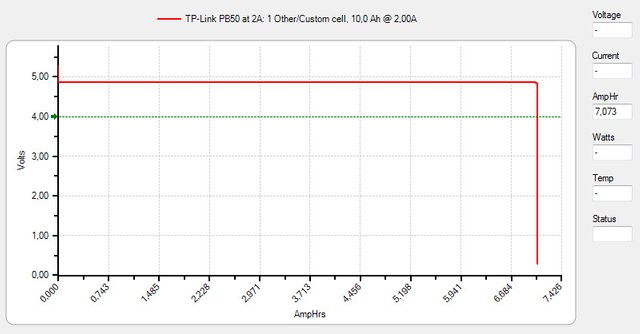
Since the TP-LINK TL-PB50 Power Bank has a second USB charge port with a 2A output rating I had to test that one as well. Again very good performance with a stable output voltage of about 4.85V (within the USB specs) and managing to get out 7073 mAh or 34.34 Wh of power in this case. This is slightly less efficient conversion at about 71% because of the 2A discharge rate used. Since the power bank can charge to devices at the same time if you do it and draw 3A the efficiency of the power conversion will drop with a few more percent again, but still remain at a good level considering what you are doing.
So what about the efficiency when charging the Lithium battery inside the power bank, this one should be higher, right? Yes, indeed it is much higher as for this we are supplying a higher voltage than needed and the step-down conversion results in less power lost in the process. It took almost 9 hours and 17 minutes to charge the fully discharged battery in the power bank and 10.585 Ah or a bit over 53 Wh. Here more energy is needed to charge the 10 Ah battery inside the power bank and note that the input here is at 5V, while the battery needs 4.2V for the actual charging process.
In the end I can say that the TP-LINK TL-PB50 Power Bank does pretty good for its price and features it offers, I have been using it absolutely problem free for a couple of months already and do plan to continue using it for a long time. It provides high capacity and good efficiency in a pretty compact size that can even fit in your pocket. The power bank also comes with a good and strong build and a number of safety features to prevent possible problems when using it. The TL-PB50 might not be the most affordable 10 Ah power bank out there, but sure is one well balanced choice and I would avoid the cheapest models just because I would expect that they will not be as good and especially as reliable and problem free on the long run as this one.
I think I overdid a bit with this review, as I often do, but hopefully you will learn something new and useful and/or interesting while reading it. You can also check some of my other product reviews already published here on steemit:
If you have any questions or want to add something, then please feel free to do so in the comments below...
Did you like what you have just read? Check my other posts on steemit @cryptos
Good post!
Not a simple tech review: an insight of the technology behind it.
@cryptos Thanks for sharing!
I'll have to look into getting one!